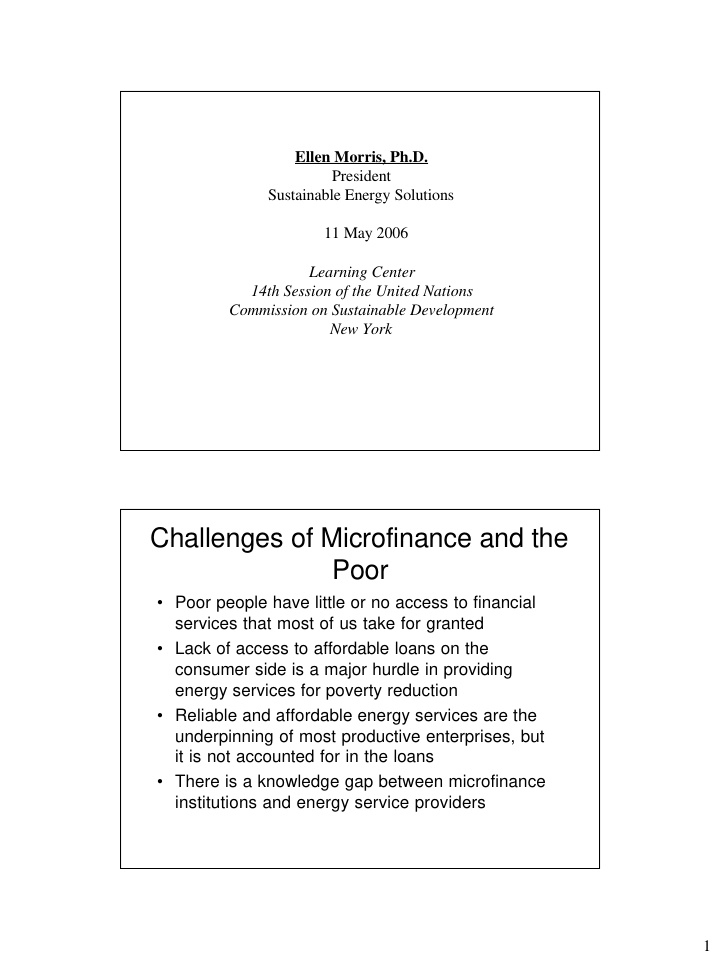



Ellen Morris, Ph.D. President Sustainable Energy Solutions 11 May 2006 Learning Center 14th Session of the United Nations Commission on Sustainable Development New York Challenges of Microfinance and the Poor • Poor people have little or no access to financial services that most of us take for granted • Lack of access to affordable loans on the consumer side is a major hurdle in providing energy services for poverty reduction • Reliable and affordable energy services are the underpinning of most productive enterprises, but it is not accounted for in the loans • There is a knowledge gap between microfinance institutions and energy service providers 1
NEEDS OF THE POOR Financing Terms Product Value • End-users matched to As per earning patterns Users Need need technology support and Technology training Must be Affordable • Lack of awareness has led to less diffusion of Quick Technical Service technology What Microfinance and Consumer Lending Can Offer • Over the last 10 years, microfinance has demonstrated that poor people can and do make use of financial services • Helps poor people raise income, increase assets, reduce vulnerability, socially empower its participants (mostly women), and contribute to broader social and economic development • Leads to improved access to education, health services, better nutrition, helping to achieve the MDGs, particularly as part of a broader development strategy • There are approximately 3000 Microfinance Institutions across the world serving more than 70 million people. 2
Why is microfinance important for increasing access to energy services? • Offers divisibility of payments • Timing of payments tuned to income stream • Often allows the client to offset a more expensive, more harmful energy source (e.g., cleaner cooking fuels) • Collateral development impacts are realized by the client and the community Bridging the gap between microfinance and access to energy services ENERGY CLIENT MICROFINANCE COMPANY INSTITUTION • Total service at • Acceptance and • Trust wit h client s doorst ep access at the village • S caling up with low • Credit at bet t er level t o client s cost t erms • Increased sales • Marketing channels • Access to reputable • Increased market • New clients energy suppliers penetration • Int roduct ion of new • Aft er sales service • Decreased loan portfolio • Access t o ot her overhead financial services 3
Financing pre-conditions • Energy product must be affordable • Financial terms must match the savings or the earnings SEWA Bank • Created by 4000 self–employed women workers who contributed share capital of Rs.10 ($0.22) each • SEWA aims to help women to come out of the vicious cycle of poverty and build capital and assets • Aim is to make women owners, users and manager • Bank of poor, self-employed women workers established in 1974 4
SEWA, SEWA Bank, and Energy members S E L C O T H M SEWA sewa SEWA BANK ENERGY N DEPARTMENT O R I T E A T S S I I N S S A E W experience G A R B A O N K • Energy loans started in late 2004 • Better methods of cooking and lighting systems are the priority •Training for SEWA Bank staff by SELCO is essential Solar Lighting - for Home based workers - for Street Hawkers 5
I mproved cook stoves - for households - for road workers Financing terms • Solar lighting systems are offered with doorstep financing • Financing terms are designed keeping in view the income earning frequency of the borrowers • Lower interest rates are offered as an incentive for timely repayments • Loan to cover battery replacement to ensure long term usage of solar lighting system 6
Income generation • Average loan size: Rs 10000 ($222) and 100% repayment • Lighting: Results in savings of Rs 15/day ($0.33) on fuel for lamps • Cooking: Results in 40% savings in fuel and 50% savings in time spent • Savings for the end user (as the maintenance and fuel costs for kerosene lanterns are higher – without even considering the health benefits) Other work in progress to promote innovation in end-user finance • Practitioner Learning Program in Africa – 3 Microfinance institutions in Uganda, Tanzania, and Zimbabwe – Learning by doing to create new lending products • Research program on energy lending in Asia, Africa, and Latin America – In-depth look at 2-3 microfinance institutions in each region – Assessment of financial performance, loan structure, clients, energy products, and development impacts 7
Summary: How microfinance and energy can have an impact • Job creation : Energy entrepreneurs • Convenience : Street vendors no longer have to maintain the dirty kerosene lamps • Better Products : Vegetables do not smell like kerosene • Saving money : The daily charges for cleaner technologies are comparable • Quality of life : Enjoying the benefits of clean energy and increased savings 8
Recommend
More recommend